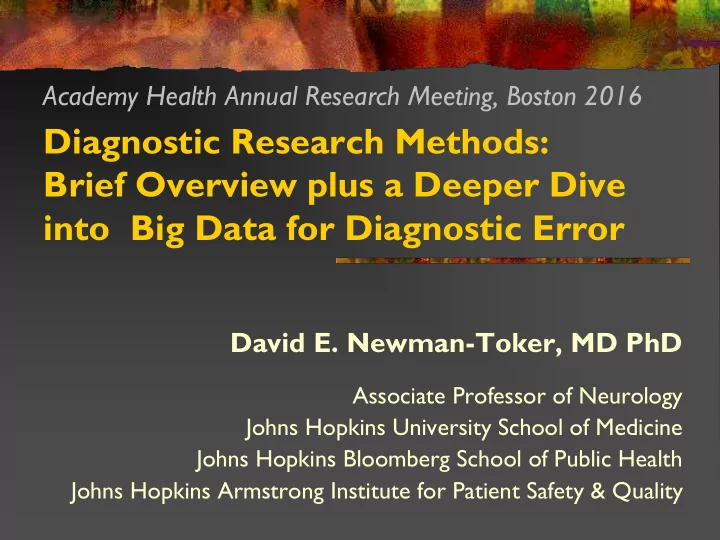

Academy Health Annual Research Meeting, Boston 2016 Diagnostic Research Methods: Brief Overview plus a Deeper Dive into Big Data for Diagnostic Error David E. Newman-Toker, MD PhD Associate Professor of Neurology Johns Hopkins University School of Medicine Johns Hopkins Bloomberg School of Public Health Johns Hopkins Armstrong Institute for Patient Safety & Quality
DISCLOSURES Grant support 1. NIH U01 DC013778-01A1 (NIDCD), 5U01NS080824, (NINDS), U24TR001609-01 (NCATS), AHRQ (pending) Siemens/SIDM, Brainscope, Kaiser Permanente Research VOG devices loaned by 2. GN Otometrics Autronics-Interacoustics Founding Board Member SIDM (unpaid) 3. ‘Diagnosis’ career focus (academic COI) 4. Investigational Use – Device
OBJECTIVES 1) Discuss the link between different diagnostic research contexts and choice of research methods 2) List at least one method for each diagnostic safety measurement objective (burden, causes, solutions) 3) Describe analytic methods and techniques to enhance ‘big data for diagnostic error’ research Newman-Toker
OUTLINE 1) Conceptual Model Defining Research Space 2) Linking Conceptual Model to Research Methods 3) Deep(er) Dive into Big Data for Diagnostic Error 4) Final Thoughts & Take Home Messages 5) Questions/Panel Discussion Newman-Toker
C ONCEPTUAL M ODEL FOR R ESEARCH S PACE
IOM Definition of Diagnostic Error DIAGNOSTIC ERROR is th e failure to… (a) establish an accurate and timely explanation of the patient’s health problem(s) or (b) communicate that explanation to the patient
Diagnostic Diagnosis Process Failure Label Failure Preventable “Near Miss” “No Fault” Diagnostic Process Failure Misdiagnosis Error Opportunity for… Quality Assurance Safety Newman-T oker, Diagnosis, 2014
N Suboptimal Optimal Diagnostic Diagnosis O Diagnostic Diagnostic Process Failure Label Failure Process Process H A R M “NEAR MISS” PROCESS PROBLEM* Preventable Standard yet UNDIAGNOSED & Diagnostic Suboptimal Care UNDIAGNOSABLE Error HARM FROM OVERTESTING & OVERDIAGNOSIS* H Opportunity for… Opportunity for… Opportunity for… A Quality Improvement Quality Assurance New Science R Dissemination Safety Discovery M Newman-T oker, Diagnosis, 2014
N Suboptimal Optimal Diagnostic Diagnosis O Diagnostic Diagnostic Process Failure Label Failure Process Process H A R M “NEAR MISS” PROCESS PROBLEM* Preventable Standard yet UNDIAGNOSED & Diagnostic Suboptimal Care UNDIAGNOSABLE Error HARM FROM OVERTESTING & OVERDIAGNOSIS* H Opportunity for… Opportunity for… Opportunity for… A Quality Improvement Quality Assurance New Science R Dissemination Safety Discovery M Newman-T oker, Diagnosis, 2014
L INKING M ODEL TO R ESEARCH M ETHODS
Opportunity for… New Science LINKING MODELS & METHODS Discovery DISCOVERY RESEARCH IN DIAGNOSIS Δ Outcomes? E2E, Cluster RCT Δ Treatment? Phase III RCT Δ Tests? Phase II RCT Accurate? Cross-Sectional Works? Validation Newman-Toker
TRIP Opportunity for… Quality Improvement Conceptual Dissemination Model (v2) Translating Research Into Practice Implementation Science Outcome Methods (e.g., Quasi-Experimental, Stepped Wedge) Pronovost, BMJ 2008
Opportunity for… LINKING MODELS & METHODS Quality Assurance Safety SAFETY DOMAINS Patient, Provider Surveys Concordance, Spectrum (OverDx) Surveillance for Unplanned Events Burden Methods (‘Meta’) Simulations, Experiments Pre-Post, Stepped Wedge Qualitative (RCA, process) Diagnostic Strategy RCT Case-Control, Cohort Meta-Analysis, Modeling Cause Solution Newman-Toker
D EEP ( ER ) D IVE INTO B IG D ATA FOR D X E RROR
BIG DATA FOR DX ERROR CASE STUDY: MISSED STROKE IN DIZZINESS A 30 year-old woman presents with new vertigo and vomiting to the ED. Woke with symptoms this morning and still has them 12 hours later. Associated with nausea, vomiting, head motion intolerance, gait unsteadiness. No other neurologic symptoms. Does the patient have a stroke? ED physician orders a CT scan of the brain. When it returns with a normal result, the patient is discharged with medication (meclizine) for “labyrinthitis” and told to follow up with their primary care provider. The patient returns 48 hours later herniating from a large posterior fossa stroke, and ends up disabled in a nursing home. Newman-Toker
LARGE CEREBELLAR INFARCTION medial PICA-territory stroke, dimensions 3.0 x 5.0 x 4.4 cm
BIG DATA FOR DX ERROR CASE STUDY: MISSED STROKE IN DIZZINESS We know this happens, but… How often? and… How can we monitor it operationally for performance feedback and to measure impact of solutions? Newman-Toker
BIG DATA FOR DX ERROR MISSED STROKE IN “BENIGN” DIZZINESS Look Back Approach : Look Forward Approach : ‘Benign’ dizziness sent home from Stroke patients more likely to have been discharged from ED with ED more likely to return with a stroke “benign” dizziness prior ~14 days within ~30 days, but not heart attack (N = ~180,000 strokes) (N = ~30,000 ED dizzy discharges)
Look Back (Outcome to Symptoms) • Dizziness • Headache Stroke • Numbness • Chest pain Myocardial • Back pain Infarction • Dyspnea • Dyspnea Pulmonary • Chest pain Embolus • Back pain
Look Forward (Symptoms to Outcome) • Stroke Dizziness • Myocardial Vertigo infarction • Pulmonary embolus • Subarachnoid hemorrhage Headache • Meningitis • Stroke • Myocardial infarction Back Pain • Aortic dissection • Spinal cord compression
BIG DATA FOR DX ERROR PEARL #1 – LUMP FOR LOOK BACK PROBLEM: SOLUTION: ‘Lump’ Sensibly Variable Granularity Administrative Data Using HCUP-CCS
BIG DATA FOR DX ERROR PEARL #2 – USE O/E, TEMPORAL ANALYSIS PROBLEM: SOLUTION: Risk of Spurious Use O/E and Association temporal profile
BIG DATA FOR DX ERROR PEARL #3 – USE CONTROL GROUPS PROBLEM: SOLUTION: Risk of Non-Specific Use Clinical Association Comparison Groups
F INAL T HOUGHTS & T AKE H OME M ESSAGES
Diagnostics Development Pipeline
Gaps in the Diagnostic Research Translational Continuum
TAKE HOME POINTS 1) Match methods to research context (discovery, dissemination, or safety) 2) Consider your measurement objectives in the safety space (burdens, causes, solutions) 3 ) With ‘big data for diagnostic error’ combine ‘look back’ with ‘look forward’ and use analytic pearls (lump, O/E-time, control) Newman-Toker
Q UESTIONS & P ANEL D ISCUSSION
DIAGNOSTIC STRATEGY RCT SOLUTIONS THROUGH INNOVATION Portable Video- oculography: The “Eye ECG” AVERT Trial (NIH-sponsored $5.5M Phase II RCT)
Recommend
More recommend